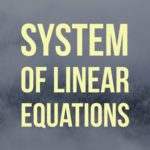Are Coefficient Matrices of the Systems of Linear Equations Nonsingular?

Problem 669
(a) Suppose that a $3\times 3$ system of linear equations is inconsistent. Is the coefficient matrix of the system nonsingular?
(b) Suppose that a $3\times 3$ homogeneous system of linear equations has a solution $x_1=0, x_2=-3, x_3=5$. Is the coefficient matrix of the system nonsingular?
(c) Let $A$ be a $4\times 4$ matrix and let
\[\mathbf{v}=\begin{bmatrix}
1 \\
2 \\
3 \\
4
\end{bmatrix} \text{ and } \mathbf{w}=\begin{bmatrix}
4 \\
3 \\
2 \\
1
\end{bmatrix}.\]
Suppose that we have $A\mathbf{v}=A\mathbf{w}$. Is the matrix $A$ nonsingular?
Sponsored Links
Contents
- Problem 669
- Hint.
- Solution.
- (a) Suppose that a $3\times 3$ system of linear equations is inconsistent. Is the coefficient matrix of the system nonsingular?
- (b) Suppose that a $3\times 3$ homogeneous system of linear equations has a solution $x_1=0, x_2=-3, x_3=5$. Is the coefficient matrix of the system nonsingular?
- (c) Suppose that we have $A\mathbf{v}=A\mathbf{w}$. Is the matrix $A$ nonsingular?
Hint.
Recall the following fact.
Let $A$ be an $n\times n$ matrix.
Then $A\mathbf{x}=\mathbf{b}$ has a unique solution for every $n\times 1$ column vector $\mathbf{b}$ if and only if $A$ is nonsingular.
Solution.
(a) Suppose that a $3\times 3$ system of linear equations is inconsistent. Is the coefficient matrix of the system nonsingular?
Let $A\mathbf{x}=\mathbf{b}$ be the system, where $A$ is the coefficient matrix and $\mathbf{b}$ is the constant term vector. Because this system is inconsistent, then $A$ is singular. (If $A$ would be nonsingular, then the system has a unique solution.)
(b) Suppose that a $3\times 3$ homogeneous system of linear equations has a solution $x_1=0, x_2=-3, x_3=5$. Is the coefficient matrix of the system nonsingular?
Recall that a homogeneous system of linear equations has always the zero solution. As the system has another solution $x_1=0, x_2=-3, x_3=5$, the system $A\mathbf{x}=\mathbf{0}$ must have infinitely many solutions. Here $A$ is the coefficient matrix.
Thus, the coefficient matrix $A$ is singular. (If $A$ would be nonsingular, the system has only one solution, which must be the zero solution.)
(c) Suppose that we have $A\mathbf{v}=A\mathbf{w}$. Is the matrix $A$ nonsingular?
Because $A\mathbf{v}=A\mathbf{w}$, we have
\[A(\mathbf{v}-\mathbf{w})=A\mathbf{v}-A\mathbf{w}=\mathbf{0}.\]
Note that
\[\mathbf{v}-\mathbf{w}=\begin{bmatrix}
1 \\
2 \\
3 \\
4
\end{bmatrix}-\begin{bmatrix}
4 \\
3 \\
2 \\
1
\end{bmatrix}=\begin{bmatrix}
-3 \\
-1 \\
1 \\
3
\end{bmatrix}\]
is a nonzero vector.
This implies that the homogeneous system $A\mathbf{x}=\mathbf{0}$ has infinitely many solutions as we have found a nonzero solution.
Hence, $A$ is singular.
 Add to solve later
Add to solve later
Sponsored Links

















